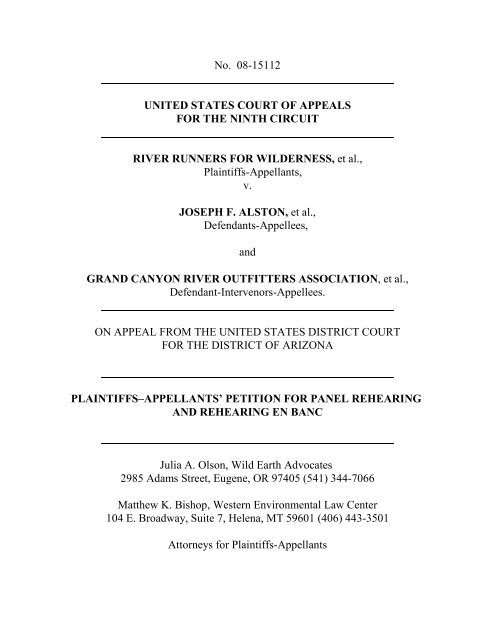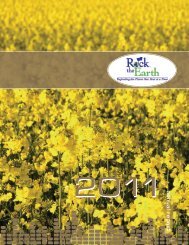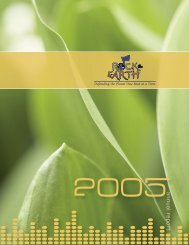Petition for Panel Rehearing and Rehearing En Banc
Petition for Panel Rehearing and Rehearing En Banc
Petition for Panel Rehearing and Rehearing En Banc
Create successful ePaper yourself
Turn your PDF publications into a flip-book with our unique Google optimized e-Paper software.
No. 08-15112<br />
UNITED STATES COURT OF APPEALS<br />
FOR THE NINTH CIRCUIT<br />
RIVER RUNNERS FOR WILDERNESS, et al.,<br />
Plaintiffs-Appellants,<br />
v.<br />
JOSEPH F. ALSTON, et al.,<br />
Defendants-Appellees,<br />
<strong>and</strong><br />
GRAND CANYON RIVER OUTFITTERS ASSOCIATION, et al.,<br />
Defendant-Intervenors-Appellees.<br />
ON APPEAL FROM THE UNITED STATES DISTRICT COURT<br />
FOR THE DISTRICT OF ARIZONA<br />
PLAINTIFFS–APPELLANTS’ PETITION FOR PANEL REHEARING<br />
AND REHEARING EN BANC<br />
Julia A. Olson, Wild Earth Advocates<br />
2985 Adams Street, Eugene, OR 97405 (541) 344-7066<br />
Matthew K. Bishop, Western <strong>En</strong>vironmental Law Center<br />
104 E. Broadway, Suite 7, Helena, MT 59601 (406) 443-3501<br />
Attorneys <strong>for</strong> Plaintiffs-Appellants
TABLE OF CONTENTS<br />
TABLE OF AUTHORITIES....................................... iii,iv<br />
INTRODUCTION ..................................................1<br />
1. The <strong>Panel</strong> Improperly Resolved Issues Never Be<strong>for</strong>e the Court. . . . . . . . . 1<br />
2. The <strong>Panel</strong>’s Opinion Holding that NPS’s Management Policies Are<br />
Unen<strong>for</strong>ceable Conflicts with Another Decision of this Court<br />
Evaluating the <strong>En</strong><strong>for</strong>ceability of NPS Management Policies. . . . . . . . . . . . 2<br />
3. The <strong>Panel</strong> Overlooked a Binding Regulation Requiring NPS to<br />
Comply with its Management Policies. . . . . . . . . . . . . . . . . . . . . . . . . . . . . 4<br />
4. The <strong>Panel</strong>’s Holding that NPS Management Policies are<br />
Unen<strong>for</strong>ceable is Fundamentally Unfair <strong>and</strong> Inconsistent with the<br />
Chevron Deference Cases. ......................................5<br />
5. The <strong>Panel</strong> Overlooked M<strong>and</strong>atory NPS Directives to Manage<br />
<strong>and</strong> Protect the River’s Wilderness Character. . . . . . . . . . . . . . . . . . . . . . . . 6<br />
6. The <strong>Panel</strong> Overlooked the Pertinent Fact that NPS Authorized New<br />
Motorized Commercial Services <strong>and</strong> Issued New Permits in Violation<br />
of § 6.3.1 ....................................................7<br />
7. The <strong>Panel</strong> Mistakes the Concessions Act as the Governing Statute<br />
<strong>for</strong> National Parks. ............................................9<br />
8. The <strong>Panel</strong>’s Necessity Ruling Under the Concessions Act is Premised<br />
on Improper Evidence. .........................................9<br />
9. The <strong>Panel</strong>’s Order Holding that NPS Complied with the Concessions<br />
Act Conflicts with the Law of this Circuit that an Agency’s Rationale<br />
Must be Contained in the FEIS. .................................10<br />
10. The <strong>Panel</strong> Mistakenly Equates the M<strong>and</strong>ate to Conserve the River’s<br />
i
Values to the Highest Practicable Degree with the Organic Act’s<br />
Non-Impairment M<strong>and</strong>ate. .....................................11<br />
11. The <strong>Panel</strong> Misinterprets River Runners’ Impairment Claim <strong>and</strong><br />
Does Not Address the Critical Legal Issue. . . . . . . . . . . . . . . . . . . . . . . . . 12<br />
12. The <strong>Panel</strong>’s Order Conflicts with this Court’s Decision in Wilderness<br />
Preservation Fund v. Kleppe, which Establishes the Legal St<strong>and</strong>ard<br />
<strong>for</strong> the Free Access Claim. .....................................13<br />
13. The <strong>Panel</strong> Overlooks Material Facts Demonstrating that the<br />
Allocations are Unfair. ........................................14<br />
CONCLUSION ...................................................15<br />
CERTIFICATE OF COMPLIANCE...................................16<br />
CERTIFICATE OF SERVICE .......................................17<br />
ATTACHMENT A ...............................................<br />
A
Cases:<br />
TABLE OF AUTHORITIES<br />
th<br />
Bicycle Trails of Marin v. Babbitt, 82 F.3d 1445 (9 Cir. 1996) . . . . . . . . . . . . .<br />
9<br />
Blue Mountains Biodiversity Project v. Blackwood, 161 F.3d 1208<br />
(9th Cir. 1998).............................................. 11<br />
Greater Yellowstone Coalition v. Kempthorne, 577 F. Supp. 2d 183<br />
(D. D.C. 2008).............................................4,13<br />
High Sierra Hikers Assn. v. Blackwell, 390 F.3d 630 (9th Cir. 2004) . . . . . . . . 9<br />
Northwest Ecosystem Alliance v. U.S. Fish <strong>and</strong> Wildlife Serv.,<br />
th<br />
475 F. 3d 1136 (9 Cir. 2007) ...................................<br />
Norton v. Southern Utah Wilderness Alliance, 124 S.Ct. 2372 (2004) . . . . . . . . . 3<br />
6<br />
Pacific Coast Fed. Of Fisherman’s Assoc. v. Nat’l Marine Fisheries Serv.,<br />
th<br />
265 F. 3d 1028 (9 Cir. 2001)..................................<br />
13<br />
River Runners <strong>for</strong> Wilderness v. Martin, – F. 3d –, 2009 WL 2151356<br />
(9th Cir. 2009)..........................................<br />
passim<br />
Sierra Club v. Mainella, 459 F. Supp. 2d 76 (D. D.C. 2006) . . . . . . . . . . . . . . 13<br />
th<br />
Smith v. Califano, 597 F. 2d 152 (9 Cir. 1979)..........................<br />
7<br />
Southern Utah Wilderness Alliance v. Nat’l Park Serv.,<br />
387 F. Supp. 2d 1178 (D. Utah 2005)............................. 4<br />
th<br />
Terbush v. U.S., 516 F.3d 1125 (9 Cir. 2008) ........................<br />
2,3,4<br />
United States v. Mead, 533 U.S. 218 (2001)............................. 6<br />
th<br />
U.S. v. Fifty Three (53) Eclectus Parrots, 685 F. 2d 1131 (9 Cir. 1982) . . . . . . .<br />
4<br />
iii
th<br />
Western Radio Services Company v. Espy, 79 F. 3d 896 (9 Cir. 1996) . . . . . . .<br />
th<br />
Wilderness Preservation Fund v. Kleppe, 608 F.2d 1250 (9 Cir. 1979) . . . . . .<br />
4<br />
14<br />
Statutes:<br />
16 U.S.C. § 1 .....................................................11<br />
Regulations:<br />
36 C.F.R. § 7.4.................................................... 5<br />
36 C.F.R. § 1.6.....................................................5<br />
Management Policies:<br />
MP § 1.4. .........................................................4<br />
MP § 1.4.3 .......................................................11<br />
MP § 1.4.4 .....................................................3,11<br />
MP § 1.4.7 ....................................................... 3<br />
MP § 4.9......................................................... 1<br />
MP § 6.3.1 .....................................................3,7,8<br />
MP § 6.3.3 ....................................................... 7<br />
MP § 6.4.3 ....................................................... 3<br />
MP § 6.4.3.3......................................................3<br />
MP § 6.4.4 ......................................................3,7<br />
iv
INTRODUCTION<br />
Pursuant to Ninth Cir. R. 40-1 <strong>and</strong> 35-1, Plaintiffs-Appellants River<br />
Runners <strong>for</strong> Wilderness et al. (“River Runners”), respectfully file this petition <strong>for</strong><br />
panel rehearing <strong>and</strong> rehearing en banc of the panel’s July 21, 2009 opinion <strong>and</strong><br />
order. See Slip Op. (attached), published as River Runners <strong>for</strong> Wilderness v.<br />
Martin, – F. 3d –, 2009 WL 2151356 (9th Cir. 2009). The panel adopted without<br />
modification “as the opinion of our court” the district court’s order affirming the<br />
National Park Service’s (“NPS’s”) Colorado River Management Plan (“CRMP”)<br />
<strong>for</strong> Gr<strong>and</strong> Canyon National Park. Slip Op. at 9279. As a result, the panel adopted<br />
an opinion that (1) resolves substantive issues that the parties did not raise, brief,<br />
or argue on appeal, (2) conflicts with other decisions of this Court,(3) fails to<br />
address or resolve important legal issues presented to it <strong>and</strong> (4) overlooks or<br />
misapprehends material points of fact <strong>and</strong> law of exceptional importance. This<br />
Court should reconsider <strong>and</strong> amend the panel’s opinion, allow <strong>for</strong> rehearing, or at<br />
the very least make its opinion <strong>and</strong> order unpublished.<br />
1. The <strong>Panel</strong> Improperly Resolved Issues Never Be<strong>for</strong>e the Court.<br />
The panel improperly resolved whether NPS violated the National<br />
<strong>En</strong>vironmental Policy Act (“NEPA”) when it prepared an environmental impact<br />
statement <strong>for</strong> the CRMP. Slip Op. at 9314-9315. River Runners was the sole<br />
1
appellant in this case <strong>and</strong> River Runners did not appeal the district court’s ruling<br />
on the NEPA claim. See Dkt. No. 4 (docketing statement); Dkt. No. 14 (opening<br />
brief); Dkt. No. 35 (reply brief). No party briefed or argued whether NPS violated<br />
NEPA. Similarly, but of less consequence in terms of establishing precedent of<br />
this Court, River Runners did not argue on appeal that the 1976 Master Plan or the<br />
1995 GMP created binding obligations on NPS, but the Court’s adoption of the<br />
district court’s order establishes precedent on those issues as well. See Slip Op. at<br />
9288. It is improper <strong>for</strong> the panel to establish precedent on claims or issues that<br />
were never appealed, briefed, or argued be<strong>for</strong>e this Court.<br />
2. The <strong>Panel</strong>’s Opinion Holding that NPS’s Management Policies are<br />
Unen<strong>for</strong>ceable Conflicts with Another Decision of this Court<br />
Evaluating the <strong>En</strong><strong>for</strong>ceability of NPS Management Policies.<br />
The panel adopted a 2007 decision of the district court that ruled that all<br />
provisions of NPS’s management policies are non-binding. Slip Op. at 9287-<br />
9294. This ruling conflicts with this Court’s 2008 ruling that provisions of the<br />
policies may be binding <strong>and</strong> en<strong>for</strong>ceable, depending on the language used. In<br />
th<br />
Terbush v. U.S., 516 F.3d 1125 (9 Cir. 2008), this Court found that the specific<br />
“sections of the polices to which [plaintiff’s] cite” do not bind the Agency because<br />
they do not include “an explicit call <strong>for</strong> a safety <strong>and</strong> hazard ‘review.’” Id. at 1132.<br />
But this Court recognized that the Agency’s policies may be binding <strong>and</strong><br />
2
en<strong>for</strong>ceable “where the language so indicates.” Id. This Court noted that,<br />
“[u]nlike wetl<strong>and</strong>s <strong>and</strong> floodplains, <strong>for</strong> which NPS elsewhere provides further<br />
requirements to be met prior to development, no further requirements are<br />
provided” <strong>for</strong> safety <strong>and</strong> hazard reviews, <strong>and</strong> that “[a]bsent further m<strong>and</strong>atory <strong>and</strong><br />
specific directives . . . NPS is left to balance its various policy m<strong>and</strong>ates of access,<br />
safety, <strong>and</strong> conservation.” Id. The Terbush approach of looking to the language<br />
of the policies to determine if specific directives exist is consistent with the<br />
Supreme Court jurisprudence that the plain language of agency documents can<br />
“create a commitment binding on the agency.” Norton v. Southern Utah<br />
Wilderness Alliance, 124 S.Ct. 2372, 2384 (2004).<br />
Here, the plain language of NPS’s policies demonstrates its intent to bind<br />
1<br />
itself. In this respect, NPS’s policies differ from the Forest Service Manual <strong>and</strong><br />
1<br />
The policies provide: “Adherence to [the MPs] is m<strong>and</strong>atory unless<br />
specifically waived or modified by the Secretary. . . Park Superintendents will be<br />
held accountable <strong>for</strong> their, <strong>and</strong> their staff’s adherence to [the MPs].” MP<br />
(Introduction). The policies’ impairment section, <strong>for</strong> instance, includes binding,<br />
m<strong>and</strong>atory language <strong>and</strong> “decision-making requirements to avoid impairment.”<br />
MP § 1.4.7; see also MP § 1.4.4 (prohibition on impairment); MP § 4.9 (NPS “will<br />
preserve . . .the natural soundscapes”); MP § 6.3.1 (NPS “must ensure that the<br />
wilderness character is . . .preserved”); MP § 6.4.3 (“Recreational uses . . .will be<br />
of a nature that enable the areas to retain their primeval character . . .[<strong>and</strong>] provide<br />
outst<strong>and</strong>ing opportunities <strong>for</strong> solitude”); MP § 6.4.3.3 (“use of motorized<br />
equipment or any <strong>for</strong>m of mechanical transport will be prohibited in wilderness”);<br />
MP § 6.4.4 (only “wilderness oriented commercial services . . .may be authorized<br />
if they meet the ‘necessary <strong>and</strong> appropriate’ tests”).<br />
3
H<strong>and</strong>book at issue in Western Radio Services Company v. Espy, 79 F. 3d 896 (9 th<br />
Cir. 1996) <strong>and</strong> the U.S. Customs Manual at issue in U.S. v. Fifty Three (53)<br />
th<br />
Eclectus Parrots, 685 F. 2d 1131 (9 Cir. 1982). Unlike the internal agency<br />
pronouncements in those cases, the NPS policy provisions include binding,<br />
m<strong>and</strong>atory language indicative of a substantive rule. See Southern Utah<br />
Wilderness Alliance v. NPS, 387 F. Supp. 2d 1178, 1189 (D. Utah 2005) (NPS’s<br />
policies “are not a general statement of policy, but prescribe substantive rules”).<br />
Indeed, since the district court issued its opinion in 2007, NPS has conceded in<br />
court “that § 1.4 [of the policies] serves as NPS’s official interpretation of the<br />
Organic Act <strong>and</strong> is there<strong>for</strong>e en<strong>for</strong>ceable against NPS.” Greater Yellowstone<br />
Coalition v. Kempthorne, 577 F. Supp. 2d 183, 190 n.1 (D. D.C. 2008). This<br />
Court should there<strong>for</strong>e reconsider <strong>and</strong> amend the panel’s order, allow <strong>for</strong><br />
rehearing, or make unpublished its adoption without modification of the district<br />
court’s opinion, because it conflicts with Terbush, Norton, <strong>and</strong> NPS’s concession<br />
in Greater Yellowstone Coalition.<br />
3. The <strong>Panel</strong> Overlooked a Binding Regulation Requiring NPS to<br />
Comply with its Management Policies.<br />
In adopting the district court’s order without modification, the panel<br />
overlooked an NPS regulation that requires compliance with its management<br />
4
policies. Pursuant to the Record of Decision (“ROD”) adopting the CRMP, NPS<br />
will issue both commercial <strong>and</strong> non-commercial permits to use the Colorado River<br />
in the Gr<strong>and</strong> Canyon. See ER 297, 418, 421, 435; see also 36 C.F.R. § 7.4 (permit<br />
requirement). NPS’s regulations m<strong>and</strong>ate that such permits “shall be consistent<br />
with applicable legislation, Federal regulations <strong>and</strong> administrative policies . . .” 36<br />
C.F.R. § 1.6. This regulation creates an en<strong>for</strong>ceable duty <strong>for</strong> NPS to comply with<br />
its policies. Even though River Runners raised <strong>and</strong> briefed this issue in the district<br />
court <strong>and</strong> on appeal, the panel’s order never addresses or resolves it.<br />
4. The <strong>Panel</strong>’s Holding that NPS Management Policies are<br />
Unen<strong>for</strong>ceable is Fundamentally Unfair <strong>and</strong> Inconsistent with the<br />
Chevron Deference Cases.<br />
The panel held that NPS’ management policies are binding on the courts<br />
but not binding on NPS. Slip Op. at 9294. According to the panel, it is<br />
appropriate <strong>for</strong> NPS to use its management policies as a shield to uphold its<br />
decisions, i.e., to give Chevron deference to the Agency’s interpretation of its<br />
policies on the ground that Congress delegated authority to NPS to interpret its<br />
statutory authority <strong>and</strong> fill gaps, but it is inappropriate to use the same policies as a<br />
sword to determine whether NPS decisions are inconsistent with the policies. Id.<br />
In other words, courts are to defer to <strong>and</strong> uphold NPS projects that are consistent<br />
with the policies but not set aside projects inconsistent with the same policies.<br />
5
This reasoning is fundamentally unfair <strong>and</strong> inconsistent with the Supreme Court’s<br />
decision in United States v. Mead, 533 U.S. 218 (2001) <strong>and</strong> this Court’s holding in<br />
Northwest Ecosystem Alliance v. U.S. Fish <strong>and</strong> Wildlife Service, 475 F. 3d 1136<br />
th<br />
(9 Cir. 2007), interpreting Mead. In these cases, no distinction is made between<br />
administrative interpretations of statutory authority that qualify <strong>for</strong> Chevron<br />
deference <strong>and</strong> the binding nature of those interpretations. Agency interpretations<br />
qualify <strong>for</strong> Chevron deference “when it appears that Congress delegated authority<br />
to the agency to generally make rules carrying the <strong>for</strong>ce of law, <strong>and</strong> that the<br />
agency interpretation claiming deference was promulgated in the exercise of that<br />
authority.” Mead, 533 U.S. at 226-227. In this case, NPS should not be allowed<br />
to have it both ways: The management policies are either entitled to Chevron<br />
deference <strong>and</strong> binding on the courts <strong>and</strong> NPS or entitled to no Chevron deference<br />
<strong>and</strong> non-binding on the Courts <strong>and</strong> NPS.<br />
5. The <strong>Panel</strong> Overlooked M<strong>and</strong>atory NPS Directives to Manage <strong>and</strong><br />
Protect the River’s Wilderness Character.<br />
The panel held that even if NPS had to comply with the management<br />
policies, the Agency did so in this case because the statement of policy section – §<br />
6.3.1 – requires NPS to manage the River corridor only to the “extent that existing<br />
non-con<strong>for</strong>ming uses allow.” Slip. Op. at 9295-9296. More specific provisions of<br />
6
the policies regarding how the River corridor is to be managed, however,<br />
supersede general policy statements. See Smith v. Califano, 597 F. 2d 152, 157<br />
th<br />
(9 Cir. 1979) (“A specific statutory provision will govern even though general<br />
provisions, if st<strong>and</strong>ing alone, would include the same subject.”). The specific<br />
policy provisions m<strong>and</strong>ate that NPS prohibit “use of motorized equipment or any<br />
<strong>for</strong>m of mechanical transport . . .in wilderness except as provided <strong>for</strong> in specific<br />
legislation.” See MP § 6.4.3.3. Moreover, only “[w]ilderness oriented<br />
commercial services that . . . provide opportunities <strong>for</strong> primitive <strong>and</strong> unconfined<br />
types of recreation may be authorized if they meet the ‘necessary <strong>and</strong> appropriate’<br />
tests.” MP § 6.4.4. The policies state that these provisions apply to all<br />
classifications of wilderness, including potential wilderness. MP § 6.3.3. NPS’s<br />
decision to authorize motorized uses of the River is inconsistent with these<br />
requirements. NPS reached this very conclusion in 1993. See ER 235 (motorized<br />
use “is inconsistent with the wilderness criteria of providing outst<strong>and</strong>ing<br />
opportunities <strong>for</strong> solitude <strong>and</strong> <strong>for</strong> a primitive <strong>and</strong> unconfined type of recreation”).<br />
Notably, the panel’s order overlooks <strong>and</strong> does not discuss these specific directives.<br />
Slip. Op. 9295-9296.<br />
6. The <strong>Panel</strong> Overlooked the Pertinent Fact that NPS Authorized New<br />
Motorized Commercial Services <strong>and</strong> Issued New Permits in Violation<br />
of § 6.3.1<br />
7
Even if the panel was correct that section 6.3.1 of the policies was the sole<br />
provision applicable to potential wilderness areas, the order disregards the legally<br />
significant fact that all of the contracts <strong>for</strong> motorized commercial services had<br />
expired at the end of 2006 <strong>and</strong> NPS issued new ten-year contracts <strong>for</strong> motorized<br />
commercial services in 2007 in accordance with the ROD, when it had no duty to<br />
issue those contracts or allow <strong>for</strong> such services. ER 297. Thus, there is no factual<br />
basis to conclude that NPS was managing the potential wilderness “to the extent<br />
that existing non-con<strong>for</strong>ming conditions allow” or that it was seeking “to remove<br />
from potential wilderness the temporary, non-con<strong>for</strong>ming conditions,” as required<br />
by section 6.3.1. MP § 6.3.1. The panel interprets section 6.3.1 to require “the<br />
Park Service to manage the Colorado River Corridor as wilderness to the extent<br />
possible given the existing use of motors.” Slip. Op. at 9296. But, when the<br />
contracts expired there was no longer an “existing use of motors” in the potential<br />
wilderness area. Likewise, when NPS issued new ten-year contracts <strong>for</strong> motorized<br />
commercial services in a potential wilderness area, it was in no way “seek[ing] to<br />
remove from potential wilderness the temporary, non-con<strong>for</strong>ming conditions” as<br />
required by the policies. On the contrary, in issuing new contracts, NPS<br />
affirmatively authorized another 10-year, non-con<strong>for</strong>ming condition over which it<br />
has complete control. The policies do not allow NPS to reauthorize non-<br />
8
con<strong>for</strong>ming uses when such uses have expired.<br />
7. The <strong>Panel</strong> Mistakes the Concessions Act as the Governing Statute <strong>for</strong><br />
National Parks.<br />
The panel incorrectly concludes that the Concessions Act provides the<br />
governing legal st<strong>and</strong>ard <strong>for</strong> activities in the National Park System. Slip. Op. at<br />
9300. The Organic Act not the Concessions Act, provides the legal st<strong>and</strong>ard <strong>for</strong><br />
managing National Park resources, just as the Wilderness Act provides the legal<br />
st<strong>and</strong>ard <strong>for</strong> managing wilderness areas. See Bicycle Trails of Marin v. Babbitt, 82<br />
th<br />
F.3d 1445, 1453 (9 Cir. 1996). Further, the panel fails to explain or reconcile<br />
how determining what is “necessary” to protect potential wilderness within<br />
National Parks under the Organic Act at issue in this case differs sufficiently from<br />
what is “necessary” to protect designated wilderness under the Wilderness Act at<br />
issue in High Sierra Hikers Assn. v. Blackwell, 390 F.3d 630 (9th Cir. 2004).<br />
These are material points of law that the panel failed to address.<br />
8. The <strong>Panel</strong>’s Necessity Ruling Under the Concessions Act is Premised<br />
on Improper Evidence.<br />
The panel makes two significant errors of material fact in ruling that NPS<br />
found that motorized services are necessary. Slip Op. at 9302-03. First, the panel<br />
fails to recognize NPS’s own admission that motorboats are a convenience, not a<br />
necessity. See ER 218, 108, 50-51. Second, the panel’s ruling is based upon<br />
9
improper evidence. The panel’s order states:<br />
‘[a]s demonstrated by the Park Service’s analysis of the no-motor<br />
alternatives, a decision by the Park Service to eliminate the motorized trip<br />
option would cause a dramatic reduction in the public availability of<br />
professionally outfitted river trips[.] Id. at 87. The Park Service explained<br />
that ‘continued authorization of motorized use <strong>for</strong> recreational river trips in<br />
the [Park] is essential . . . to meeting the . . . management objectives’ <strong>for</strong> the<br />
2006 CRMP. Id. Thus, the Park Service quite clearly concluded that<br />
motorized commercial services were ‘necessary <strong>and</strong> appropriate <strong>for</strong> public<br />
use <strong>and</strong> enjoyment’ of the Corridor.<br />
Slip. Op. at 9303. But each of these quotes is a public comment, not any analysis<br />
or determination by NPS. See ER 347 (Public Comment C8); compare ER 348<br />
(NPS Response to Public Comment C8). At oral argument, counsel <strong>for</strong> NPS<br />
argued that the Agency had found that these services are necessary, but he too<br />
cited the public comments, not any agency finding or explanation. The panel is<br />
correct that a “necessity” finding is a prerequisite to authorizing such services, but<br />
it is incorrect that NPS ever found that they are necessary. The panel’s adoption<br />
of this mistake by the district court compounds the error.<br />
9. The <strong>Panel</strong>’s Order Holding that NPS Complied with the Concessions<br />
Act Conflicts with the Law of this Circuit that an Agency’s Rationale<br />
Must be Contained in the FEIS.<br />
The panel recognizes that “the FEIS <strong>and</strong> ROD do not contain a specific<br />
discussion of the amount of motorized traffic found necessary <strong>and</strong> appropriate <strong>for</strong><br />
public use <strong>and</strong> enjoyment of the Corridor.” Slip. Op. at 9303. The panel<br />
10
nonetheless upheld NPS’s finding on the grounds that “the Park Service’s decision<br />
concerning the amount of motorized trips on the river was made after considering<br />
competing alternatives <strong>and</strong> a significant number of variables.” Slip. Op. at 9306.<br />
But none of the variables or alternatives considered by NPS, <strong>and</strong> presented in the<br />
FEIS, considered need. As such, NPS’s FEIS is devoid of the requisite necessity<br />
determination <strong>and</strong> this is where the agency’s defense of its position must be found.<br />
Blue Mountains Biodiversity Project v. Blackwood, 161 F.3d 1208, 1214 (9th Cir.<br />
1998).<br />
10. The <strong>Panel</strong> Mistakenly Equates the M<strong>and</strong>ate to Conserve the River’s<br />
Values to the Highest Practicable Degree with the Organic Act’s<br />
Non-Impairment M<strong>and</strong>ate.<br />
The panel acknowledges the adverse effects of NPS’s decision on the Gr<strong>and</strong><br />
Canyon’s natural soundscape, but apparently concludes that the Park’s natural<br />
soundscape is conserved to the “highest practicable degree” as required by the<br />
Concessions Act because it remains “unimpaired.” Slip. Op. at 9308. The duty to<br />
conserve park resources to the highest practicable degree, however, is a separate<br />
<strong>and</strong> distinct duty from the duty to prevent impairment under the Organic Act. See<br />
16 U.S.C. § 1; MP §§ 1.4.3, 1.4.4. Neither the panel nor NPS has cited a single<br />
page in the record where the Agency explains how the major adverse impacts from<br />
motorized services to the soundscape <strong>and</strong> other adverse impacts to visitors<br />
11
opportunities <strong>for</strong> solitude <strong>and</strong> primitive <strong>and</strong> unconfined recreation is consistent<br />
with protecting the values of the river to the highest practicable degree.<br />
11. The <strong>Panel</strong> Misinterprets River Runners’ Impairment Claim <strong>and</strong> Does<br />
Not Address the Critical Legal Issue.<br />
The panel upheld NPS’s conclusion that increased motorized use of the<br />
River corridor (i.e., motorboats, helicopter passenger exchanges, <strong>and</strong> generators),<br />
in conjunction with existing aircraft overflights would not impair the Gr<strong>and</strong><br />
Canyon’s natural soundscape. In so doing, the panel overlooked <strong>and</strong><br />
misinterpreted River Runners’ claim. River Runners do not argue that the<br />
motorized river traffic – by itself – causes impairment or that motorized river<br />
traffic must be eliminated in order to restore the Gr<strong>and</strong> Canyon’s natural<br />
soundscape. (The Parties, in fact, agreed to bifurcate the liability <strong>and</strong> remedy<br />
phases of this civil action).<br />
On the contrary, River Rivers maintain that NPS’s impairment<br />
determination is arbitrary <strong>and</strong> capricious because NPS failed to provide a rational<br />
connection between the facts found in the FEIS, i.e., that the cumulative impacts<br />
to the Gr<strong>and</strong> Canyon’s natural soundscape are “major” <strong>and</strong> “significant,” <strong>and</strong> the<br />
decision made, i.e., that authorizing more motorized use to an already degraded<br />
environment will not cumulatively impair the Gr<strong>and</strong> Canyon’s natural soundscape.<br />
12
See Pacific Coast Fed. Of Fisherman’s Assoc. v. NMFS, 265 F. 3d 1028, 1034 (9 th<br />
Cir. 2001) (we must ask whether the agency “articulated a rational connection<br />
between the facts found <strong>and</strong> the choice made”). Much like the Agency’s approach<br />
to snowmobiling in Yellowstone National Park which was rejected by the D.C.<br />
District Court in Greater Yellowstone Coalition v. Kempthorne, 577 F. Supp. 2d<br />
183, 195 (D. D.C. 2008), NPS never explained how it could find “major” <strong>and</strong><br />
“significant” cumulative impacts to the Gr<strong>and</strong> Canyon’s natural soundscape from<br />
aircraft overflights, air tours, <strong>and</strong> motorized use of the River in the FEIS <strong>and</strong> still<br />
reach a no-impairment determination. After all, there “is no higher level than<br />
‘major’ on the impact scale.” Greater Yellowstone Coalition, 577 F. Supp. 2d at<br />
202. When making an impairment determination, NPS must do more than merely<br />
reference a NEPA analysis <strong>and</strong> then ignore its findings. It must provide an<br />
adequate explanation – a rationale – <strong>for</strong> finding that the cumulative impacts do not<br />
rise to the level of impairment. As noted by one court “[m]erely describing an<br />
impact <strong>and</strong> stating a conclusion of non-impairment is insufficient, <strong>for</strong> this merely<br />
sets <strong>for</strong>th ‘the facts found’ <strong>and</strong> ‘the choice made,’ without revealing the ‘rational<br />
connection – the agency’s rationale <strong>for</strong> finding that the impact described is not<br />
impairment.” Sierra Club v. Mainella, 459 F. Supp. 2d 76,100 (D. D.C. 2006).<br />
12. The <strong>Panel</strong>’s Order Conflicts with Wilderness Preservation Fund v.<br />
13
Kleppe, which Establishes the Legal St<strong>and</strong>ard <strong>for</strong> the Free Access<br />
Claim.<br />
The panel does not state nor apply the relevant legal st<strong>and</strong>ard articulated in<br />
Kleppe that “allocation [be] fairly made pursuant to appropriate st<strong>and</strong>ards.” 608<br />
th<br />
F.2d 1250, 1254 (9 Cir. 1979); see Slip. Op. at 9308-9311. Instead, the panel<br />
appears to adopt a new legal st<strong>and</strong>ard, which is: whether or not intervenors, who<br />
represent the commercial outfitters <strong>and</strong> a subset of private boaters, believe that the<br />
allocation is fair. Slip. Op. at 9308-9311 (twice stating, including in conclusion,<br />
that certain organizations thought the allocation was fair.) That is not a st<strong>and</strong>ard<br />
of fairness anymore than it would be to state that the allocations are unfair simply<br />
because River Runners may not like them. The court never articulates any<br />
st<strong>and</strong>ard of fairness used by NPS in allocating use in a split system.<br />
13. The <strong>Panel</strong> Overlooks Material Facts Demonstrating that the<br />
Allocations are Unfair.<br />
Evidence in the record demonstrates that people who do not want nor need<br />
commercial services have to use such services in order to gain access to the<br />
Colorado River. See ER 281-283, 286 -287. The panel’s order does not address<br />
this evidence in the context of the Concessions Act claim where River Runners<br />
argue that unnecessary amounts of commercial services are authorized nor in the<br />
context of River Runners’ Organic Act free access claim where we argue that the<br />
14
allocations are inequitable, <strong>for</strong>cing the public to pay commercial outfitters <strong>for</strong><br />
access to their public l<strong>and</strong>s <strong>and</strong> waters. In fact, this crucial evidence is not<br />
discussed or mentioned anywhere in the panel’s order. Slip. Op. at 9277-9316.<br />
CONCLUSION<br />
River Runners respectfully request that this Court reverse the panel’s<br />
decision or restore the case to the calendar <strong>for</strong> re-argument or re-submission. In<br />
the alternative, this Court should issue a new or modified opinion, rectifying <strong>and</strong><br />
addressing the errors stated above. Finally, if this Court chooses to affirm without<br />
modification the district court’s decision, it should do so in an unpublished<br />
opinion that does not establish new <strong>and</strong> conflicting precedent within the Court.<br />
Dated: September 3, 2009.<br />
Respectfully submitted,<br />
/s/ Julia Olson<br />
Julia A. Olson<br />
Wild Earth Advocates<br />
2985 Adams Street<br />
Eugene, OR 97405<br />
(541) 344-7066<br />
jaoearth@aol.com<br />
/s/ Matthew Bishop<br />
Matthew K. Bishop<br />
Western <strong>En</strong>vironmental Law Center<br />
103 Reeder’s Alley<br />
Helena, MT 59601<br />
(406) 324-8011<br />
bishop@westernlaw.org<br />
Attorneys <strong>for</strong> Plaintiffs-Appellants<br />
15
CERTIFICATE OF COMPLIANCE<br />
Pursuant to Ninth Cir. R. 40-1 <strong>and</strong> 35-1, undersigned counsel of record <strong>for</strong><br />
River Runners hereby certifies that this <strong>Petition</strong> <strong>for</strong> <strong>Panel</strong> <strong>Rehearing</strong> <strong>and</strong><br />
<strong>Rehearing</strong> <strong>En</strong> <strong>Banc</strong> is proportionally spaced, has a typeface of 14 points or more,<br />
contains 3413 words <strong>and</strong> is within the 15 page limit. River Runners’ counsel<br />
relied on Corel Word Perfect 12 to obtain the word count.<br />
/s/ Julia A. Olson<br />
Julia A. Olson<br />
16
CERTIFICATE OF SERVICE<br />
I hereby certify that on September 3, 2009, I electronically served<br />
Plaintiffs-Appellants’ <strong>Petition</strong> <strong>for</strong> <strong>Panel</strong> <strong>Rehearing</strong> <strong>and</strong> <strong>Rehearing</strong> <strong>En</strong> <strong>Banc</strong> on the<br />
following counsel of record, via the Electonic Case Filing system of the Ninth<br />
Circuit Court of Appeals:<br />
Charles R. Scott<br />
U.S. Department of Justice<br />
ENRD – Appellate Section<br />
P.O. Box 23795 – L’ <strong>En</strong>fant Plaza Station<br />
Washington, D.C. 20026-3795<br />
Jonathan Simon<br />
Sam Kalen<br />
Van Ness Feldman, P.C.<br />
1050 Thomas Jefferson Street, N.W.<br />
Washington, D.C. 20007-3877<br />
Lori Potter<br />
Kaplan Kirsch & Rockwell LLP<br />
1675 Broadway, Suite 2300<br />
Denver, CO 80202<br />
/s/ Julia A. Olson<br />
Julia A. Olson










